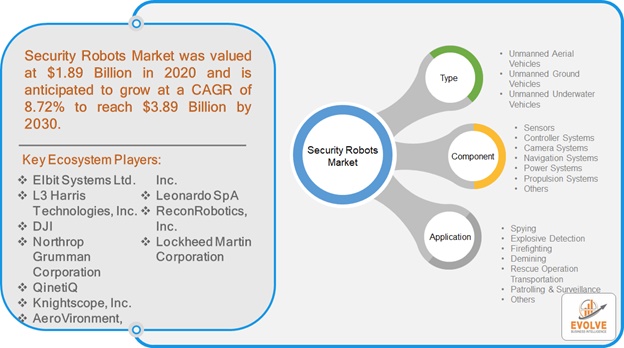The global Security Robots market size is projected to reach approximately $ 3.89 Billion by 2030, at a CAGR of 8.72% from 2022 to 2030. Security robots are machines that provide security in public places without requiring human supervision. Security robots obtain and gather data through the use of infrared devices, radars, and thermal sensors. Security robots are designed to provide mobile CCTV monitoring and replace patrol guards. Security robots are capable of moving around a restricted area without human interference. Furthermore, they can send images due to their built-in cameras to the monitoring center. Due to the rapid advancements and developments in technology, the demand for unmanned vehicles and aircraft solutions by the defense sector has grown significantly.
COVID-19 Impact Analysis
With the functionality of security robots growing and a pandemic on the rise, more companies are beginning to look at AI security options. They identify autonomous security robots as an attractive way to cut costs and increase efficiency during a time when their number one concern is COVID-19. With the escalation of the pandemic COVID-19, privatized security and asset protection companies began using security robots in their business. Occupational risks have continually arisen with the remote worker-to-worker exposure.
Market Dynamics
The factors driving the growth of the global Security Robots market include rising geopolitical instabilities and territorial conflicts, increasing demand from military and defense forces globally, increasing defense expenditure of emerging economies such as India and China as well as the growing adoption of autonomous systems for security robots.
Drivers:
⮚ Increasing Geopolitical Instabilities and Territorial Conflicts
The number of active conflicts all over the world is rising constantly, particularly over the last decade. The European refugee crisis which started in 2015, witnessed an increasing number of refugees and migrants traveling to the European Union (EU) to seek asylum. Furthermore, in 2014, Russian- backed forces seized control of Crimea, a Ukrainian peninsula, which is situated on the northern coast of the Black Sea. Moreover, Pakistan and India have constant friction and disputes along the line of control (LoC) as well as over Pakistan-occupiedPakistan-occupied Kashmir (PoK). There have also been disputes in the South and the East China Sea since many countries are trying to gain control over many strategically important islands. Security robots such as UAVs provide enhanced capabilities to resist violent extremism. The identifying and refuting constituents provide proactive measures to identify terrorist activities. Therefore, the use of unmanned systems and advanced security robots is a major driver of the security robots market.
Restraint:
- Stringent Regulations and Privacy Concerns
The stringent regulations related to the development of unmanned system solutions may hamper the growth of the market, as these machines usually have a level of accuracy that must be adhered to. Another important part of the Security Robots market is Privacy Intrusion. Due to this security concern that has been working as a barrier to growth, it will be necessary to assess other risk factors and integrate robots with those risks
Opportunity:
⮚ Growing Adoption of Unmanned Vehicles
The demand for unmanned vehicles by the army and defense forces is increasing rapidly. The growth in the defense budgets of developed nations further fuels the demand. Security robots are used for military operations, to enter dangerous areas, as well as to handle and disable bombs in unknown regions. They can fulfill different tasks with help of cameras and sensors. The operator can control the robot from a safe distance. Security robots thus save human lives from unexpected dangers and are safer as well as more effective, thereby driving the growth of the security robots market considerably.
Segment Overview
By Type
Based on the Type the Security Robots market is segmented based on Unmanned Aerial Vehicles, Unmanned Ground Vehicles, and Unmanned Underwater Vehicles. Unmanned aerial vehicles are expected to hold a large market share as it is a valuable strategy for dealing with terrorist activities. The unmanned autonomous vehicle performs roles such as surveillance, mine countermeasures, intelligence, and delivery of ammunition and sensor deployment. It also boasts certain roles in anti-submarine warfare.
By Component
Based on Components, the global Security Robots market has been divided into Sensors, Controller Systems, Camera Systems, Navigation Systems, Power Systems, Propulsion Systems, and Others. The Camera Systems segment is expected to hold the largest market share. Some companies and organizations use camera systems for round-the-clock monitoring, investigation, surveillance, border control, and infrastructure protection. Other uses include field inspection of inaccessible buildings as well as thermography inspections.
By Application
Based on Application, the global Security Robots market has been divided into Spying, Explosive Detection, Firefighting, Demining, Rescue Operations, Transportation, Patrolling & Surveillance, and Others. The Patrolling & Surveillance segment is expected to hold the largest market share due to the growing demand for the highest level of security on the premises to guard commercial facilities and promising government investment to set up Managed Security Robotics Services. In October 2020, SEO launched the “ARVO” service robot in South Korea which provides security services such as patrol and inspection with the combination of CCTV and various sensors.
Global Security Robots Market Share, by Segmentation
 Regional Analysis
Regional Analysis
Based on region, the global Security Robots market has been divided into North America, Europe, Asia-Pacific, and the Rest of the World. North America is projected to dominate the use of the Security Robots market followed by the Asia-Pacific and Europe regions.
North America Market
North America contributed the largest share to the global Security Robots market. The increased adoption of unmanned aerial vehicles in the US by forces including US Navy Seals, Delta Force, and security and surveillance force, combined with the military expansion is driving the creation of new opportunities in the industry. The drone manufacturing market within North America is set to grow as more major companies are expanding their operations. While there will continue to be healthy consumer demand, growth amongst the region’s homegrown companies is also expected.
Asia-Pacific Market
The The Asia Pacific is expected to witness the highest growth during the forecast period which is attributed to the rising investment inin strengthening the surveillance and weapon guidance capabilities in India, Japan,, and China, along with the surge in expenditures by the government to tackle terrorist attacks, criminal activities, infiltration, and illegal immigration.
Competitive Landscape
The market comprises tier-1, tier-2, and local players. With their wide product portfolios, tier-1 and tier-2 players have a global reach. Because of their strategic innovations and broad regional presence, companies such as Elbit Systems Ltd., L3 Harris Technologies, Inc., DJI, Northrop Grumman Corporation, QinetiQ, Knightscope, Inc., AeroVironment, Inc., Leonardo SpA, ReconRobotics, Inc., and Lockheed Martin Corporation, lead the global Security Robots business. To increase their market position and attract a wide consumer base, the businesses are employing various strategies, such as growth, product releases, and alliances.
Prominent Players:
- Elbit Systems Ltd.
- L3 Harris Technologies, Inc.
- DJI
- Northrop Grumman Corporation
- QinetiQ
- Knightscope, Inc.
- AeroVironment, Inc.
- Leonardo SpA
- ReconRobotics, Inc.
- Lockheed Martin Corporation
In January 2020, ReconRobotics Inc., the world leader in tactical micro-robot systems, announced the approval of their 6th US patent, US 10,526,029 B2 for a Two Wheeler Robot with Covertibitly and Accessories. ReconRobotics constantly innovates and develops proprietary combinations of engineering, durability, and technology.
Scope of the Report
Global Security Robots Market, by Type
- Unmanned Aerial Vehicles
- Unmanned Ground Vehicles
- Unmanned Underwater Vehicles
Global Security Robots Market, by Component
- Sensors
- Controller Systems
- Camera Systems
- Navigation Systems
- Power Systems
- Propulsion Systems
- Others
Global Security Robots Market, by Application
- Spying
- Explosive Detection
- Firefighting
- Demining
- Rescue Operation Transportation
- Patrolling & Surveillance
- Others
Global Security Robots Market, by Region
- North America
- US
- Canada
- Mexico
- Europe
- UK
- Germany
- France
- Italy
- Rest of Europe
- Asia Pacific
- China
- Japan
- South Korea
- India
- Rest of Asia Pacific
- Rest of the World
| Parameters | Indicators |
|---|---|
| Market Size | 2030: $ 3.89 Billion |
| CAGR | 8.72% CAGR (2022-2030) |
| Base year | 2021 |
| Forecast Period | 2022-2030 |
| Historical Data | 2020 |
| Report Coverage | Revenue Forecast, Competitive Landscape, Growth Factors, and Trends |
| Key Segmentations | Type, Component, and Application |
| Geographies Covered | North America, Europe, Asia-Pacific, Latin America, Middle East, Africa |
| Key Vendors | Elbit Systems Ltd., L3 Harris Technologies, Inc., DJI, Northrop Grumman Corporation, QinetiQ, Knightscope, Inc., AeroVironment, Inc., Leonardo SpA, ReconRobotics, Inc., and Lockheed Martin Corporation |
| Key Market Opportunities | Growing Adoption of Unmanned Vehicles |
| Key Market Drivers | Increasing Geopolitical Instabilities and Territorial Conflicts |
REPORT CONTENT BRIEF:
- High-level analysis of the current and future Security Robots market trends and opportunities
- Detailed analysis of current market drivers, restraining factors, and opportunities in the future
- Security Robots market historical market size for the year 2020, and forecast from 2021 to 2028
- Security Robots market share analysis at each product level
- Competitor analysis with a detailed insight into its product segment, financial strength, and strategies adopted.
- Identifies key strategies adopted including product launches and developments, mergers and acquisitions, joint ventures, collaborations, and partnerships as well as funding taken and investment done, among others.
- To identify and understand the various factors involved in the global Security Robots market affected by the pandemic
- To provide a detailed insight into the major companies operating in the market. The profiling will include the financial health of the company past 2-3 years with segmental and regional revenue breakup, product offering, recent developments, SWOT analysis, and key strategies.






